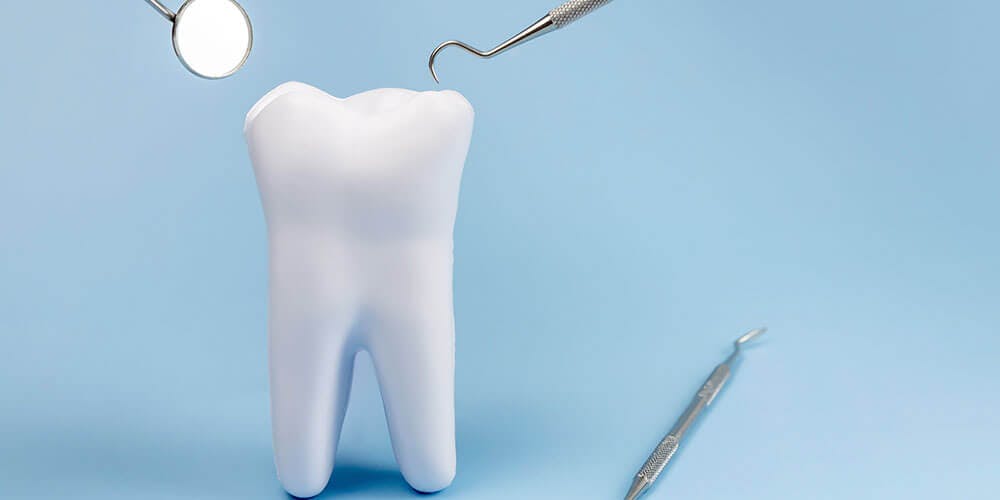Posted by Dr. Taner Cakmak on Fri, 13 Sep 2024
Kanata South Dental - Dentist Kanata

CAN A CRACKED TOOTH BE SERIOUS?
Yes, a cracked tooth can be serious depending on the extent of the crack. Some cracks may cause little to no pain and can be easily repaired, while others may result in significant discomfort and require more extensive treatment.
Here are some possible complications of a cracked tooth:
- Pain and Sensitivity: A cracked tooth can cause pain, especially when chewing or if the crack exposes the tooth's inner layers. Sensitivity to hot and cold is also common.
- Infection: If the crack reaches the pulp (the inner soft tissue containing nerves and blood vessels), bacteria can enter and cause an infection, which may lead to the formation of an abscess.
- Tooth Loss: If the crack is severe and extends below the gum line, it may not be possible to save the tooth. In such cases, extraction may be required.
- Difficulty Chewing: A cracked tooth can weaken the tooth structure, making it more prone to further damage while chewing.
Treatment options depend on the severity of the crack and include bonding, crowns, root canals, or, in extreme cases, extraction. Early diagnosis and treatment by a dentist are essential to prevent more serious complications.
HOW LONG BEFORE A CRACKED TOOTH BECOMES INFECTED?
The time it takes for a cracked tooth to become infected varies depending on the severity of the crack, the location, and whether bacteria are able to enter the tooth's inner layers (especially the pulp). There’s no specific timeline, but here are key factors that influence the risk of infection:
- Depth of the Crack: If the crack extends into the dentin or pulp (the soft tissue containing nerves and blood vessels), bacteria can more easily enter, increasing the risk of infection. In such cases, infection may develop quickly, sometimes within days to weeks.
- Exposure to Bacteria: If the crack allows saliva and food particles to enter the tooth, bacteria can reach the pulp more rapidly, speeding up the infection process.
- Symptoms: If you notice increased pain, swelling, or sensitivity to hot, cold, or sweet foods, these may be signs that the tooth is already infected or at high risk of infection.
- Oral Hygiene: Poor oral hygiene can also contribute to a faster onset of infection. Regular brushing, flossing, and rinsing with an antibacterial mouthwash can help slow bacterial growth.
If a cracked tooth is left untreated, infection may spread to the surrounding gums and bone, potentially leading to more serious complications like an abscess. It's best to see a dentist as soon as possible to prevent infection from developing.
DOES A CRACKED TOOTH NEED TO BE PULLED?
A cracked tooth does not always need to be pulled. Whether extraction is necessary depends on the severity and location of the crack. In many cases, dentists can save a cracked tooth using various treatments. Here are the key factors that determine whether a cracked tooth needs to be pulled:
When a Cracked Tooth Can Be Saved:
- Minor Cracks (Craze Lines): These small cracks affect only the outer enamel and usually don't require treatment. They often don’t cause pain and can be left alone or treated for cosmetic reasons.
- Cracked Tooth That Doesn’t Extend Below the Gum Line: If the crack is contained above the gum line and hasn’t reached the tooth’s root, the tooth can often be saved with treatments like:
- Dental bonding to seal the crack.
- Crown to cover and protect the tooth from further damage.
- Root canal if the crack has reached the pulp but hasn’t extended into the root.
When Extraction Might Be Necessary:
- Crack Extends Below the Gum Line: If the crack extends below the gum line or into the tooth’s root, it may be impossible to save the tooth. In such cases, extraction is often necessary.
- Vertical Root Fractures: These cracks start at the root and move upward. Since they affect the entire structure of the tooth, extraction is usually required.
- Severe Damage or Infection: If the tooth is severely cracked and cannot be repaired, or if it becomes infected and the infection is widespread, pulling the tooth might be the best option to prevent further complications.
Dentists aim to save teeth whenever possible, so extraction is generally considered a last resort. If you suspect a cracked tooth, early evaluation and treatment can often prevent the need for extraction.
WHAT NOT TO DO WHEN YOU HAVE A CRACKED TOOTH?
When you have a cracked tooth, there are certain things you should avoid to prevent further damage, reduce discomfort, and minimize the risk of infection. Here’s what not to do when dealing with a cracked tooth:
- Avoid Chewing on the Affected Side:
- Chewing on the cracked tooth can worsen the crack and cause additional pain. Stick to chewing on the opposite side of your mouth until the tooth is treated.
- Don’t Eat Hard or Crunchy Foods:
- Hard foods like nuts, ice, hard candies, and crunchy items can put pressure on the cracked tooth and make the crack worse.
- Sticky or chewy foods like caramel or gum should also be avoided, as they can pull on the tooth and worsen the crack.
- Avoid Extreme Temperatures:
- Hot or cold foods and drinks can increase sensitivity and pain. Try to stick to lukewarm options until the tooth is treated.
- Don’t Use the Tooth for Cutting or Biting:
- Avoid biting into tough or hard foods, like biting into whole apples, corn on the cob, or tough meats, as this can put additional strain on the cracked tooth.
- Don’t Clench or Grind Your Teeth:
- Teeth grinding (bruxism) can exacerbate cracks in teeth. If you have a habit of grinding your teeth or clenching your jaw, try to minimize this behavior, especially at night. Your dentist may suggest a mouthguard if this is an issue.
- Avoid Self-Treatment:
- Trying to fix or manipulate the cracked tooth yourself can lead to more damage. Over-the-counter temporary filling materials are sometimes available, but they are not a long-term solution.
- Don’t Delay Treatment:
- Avoid postponing a visit to the dentist. A cracked tooth left untreated can worsen and lead to infection, which may require more extensive treatments like a root canal or extraction.
In the meantime, you can manage discomfort with over-the-counter pain relievers and avoid putting pressure on the affected tooth. Seeking prompt dental care is the best way to prevent complications.
WHAT IS THE DIFFERENCE BETWEEN A CRACKED TOOTH AND A SPLIT TOOTH?
The difference between a cracked tooth and a split tooth primarily lies in the extent and severity of the damage. Here's a breakdown of the two conditions:
Cracked Tooth:
- Definition: A cracked tooth has a fracture that may extend through part of the tooth but not completely separate it into distinct sections. The crack can range from shallow (affecting only the enamel) to deep (reaching the inner layers, such as the dentin or pulp).
- Extent of Damage: The crack is typically incomplete, meaning the tooth is still intact, though it may cause pain and sensitivity.
- Symptoms:
- Pain when chewing or biting.
- Sensitivity to temperature (hot or cold).
- Pain that comes and goes, particularly when releasing pressure after biting.
- Sometimes, no symptoms at all.
- Treatability: Many cracked teeth can be saved with treatments like bonding, crowns, or root canals if the crack hasn't reached the root or below the gum line.
Split Tooth:
- Definition: A split tooth is a more severe progression of a cracked tooth. In this case, the crack has extended completely, dividing the tooth into two or more separate segments.
- Extent of Damage: The tooth is fully split, often running from the surface of the tooth down to the root, and may extend below the gum line.
- Symptoms:
- Severe pain, especially when chewing.
- Visible separation or movement of the tooth segments.
- Swelling or infection in the surrounding gums.
- Treatability: Once a tooth is split, it is much harder to save. Depending on how far the split extends, parts of the tooth may need to be extracted. In some cases, part of the tooth may be salvageable with treatments like crowns or root canals, but often extraction is required.
Key Differences:
- Severity: A cracked tooth involves an incomplete fracture, while a split tooth indicates that the crack has fully divided the tooth.
- Treatment: Cracked teeth can often be treated and saved, while split teeth frequently require extraction, especially if the split extends below the gum line.
Early treatment of a cracked tooth can often prevent it from progressing into a split tooth.
Dentist Kanata
We will gladly answer any questions you may have.
Ask QuestionsKanata South Dental offers the ability to request your dentist appointments online. Schedule an appointment now!
Book OnlineBy filling out the New Patient Forms ahead of time you will save significant time on your visit.
New Patient FormsLatest News
Key Benefits of Dental Cleaning
Fri, 9 Jan 2026Key Benefits of Dental Cleaning (And What Happens If You Skip Them) Regular dental cleanings play an important role in keeping yo...
Continue Reading